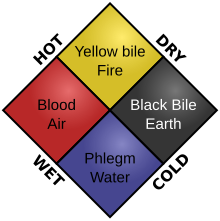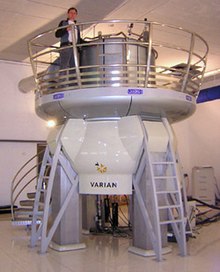History of biochemistry
| Part of a series on |
| Biochemistry |
|---|
 |
The history of biochemistry can be said to have started with the ancient Greeks who were interested in the composition and processes of life, although biochemistry as a specific scientific discipline has its beginning around the early 19th century.[1] Some argued that the beginning of biochemistry may have been the discovery of the first enzyme, diastase (today called amylase), in 1833 by Anselme Payen,[2] while others considered Eduard Buchner's first demonstration of a complex biochemical process alcoholic fermentation in cell-free extracts to be the birth of biochemistry.[3][4] Some might also point to the influential work of Justus von Liebig from 1842, Animal chemistry, or, Organic chemistry in its applications to physiology and pathology, which presented a chemical theory of metabolism,[1] or even earlier to the 18th century studies on fermentation and respiration by Antoine Lavoisier.[5][6]
The term
The subject of study in biochemistry is the chemical processes in living organisms, and its history involves the discovery and understanding of the complex components of life and the elucidation of pathways of biochemical processes. Much of biochemistry deals with the structures and functions of cellular components such as proteins, carbohydrates, lipids, nucleic acids and other biomolecules; their metabolic pathways and flow of chemical energy through metabolism; how biological molecules give rise to the processes that occur within living cells; it also focuses on the biochemical processes involved in the control of information flow through biochemical signalling, and how they relate to the functioning of whole organisms. Over the last 40 years[as of?] the field has had success in explaining living processes such that now almost all areas of the life sciences from botany to medicine are engaged in biochemical research.
Among the vast number of different biomolecules, many are complex and large molecules (called polymers), which are composed of similar repeating subunits (called monomers). Each class of polymeric biomolecule has a different set of subunit types. For example, a protein is a polymer whose subunits are selected from a set of twenty or more amino acids, carbohydrates are formed from sugars known as monosaccharides, oligosaccharides, and polysaccharides, lipids are formed from fatty acids and glycerols, and nucleic acids are formed from nucleotides. Biochemistry studies the chemical properties of important biological molecules, like proteins, and in particular the chemistry of enzyme-catalyzed reactions. The biochemistry of cell metabolism and the endocrine system has been extensively described. Other areas of biochemistry include the
Proto-biochemistry

In a sense, the study of biochemistry can be considered to have started in ancient times, for example when
Enzymes

As early as the late 18th century and early 19th century, the digestion of meat by stomach secretions[16] and the conversion of starch to sugars by plant extracts and saliva were known. However, the mechanism by which this occurred had not been identified.[17]
In the 19th century, when studying the
In 1833 Anselme Payen discovered the first enzyme, diastase,[19] and in 1878 German physiologist Wilhelm Kühne (1837–1900) coined the term enzyme, which comes from Greek ενζυμον 'in leaven', to describe this process. The word enzyme was used later to refer to nonliving substances such as pepsin, and the word ferment was used to refer to chemical activity produced by living organisms.
In 1897

Having shown that enzymes could function outside a living cell, the next step was to determine their biochemical nature. Many early workers noted that enzymatic activity was associated with proteins, but several scientists (such as Nobel laureate Richard Willstätter) argued that proteins were merely carriers for the true enzymes and that proteins per se were incapable of catalysis. However, in 1926, James B. Sumner showed that the enzyme urease was a pure protein and crystallized it; Sumner did likewise for the enzyme catalase in 1937. The conclusion that pure proteins can be enzymes was definitively proved by Northrop and Stanley, who worked on the digestive enzymes pepsin (1930), trypsin, and chymotrypsin. These three scientists were awarded the 1946 Nobel Prize in Chemistry.[22]
This discovery, that enzymes could be crystallized, meant that scientists eventually could solve their structures by x-ray crystallography. This was first done for lysozyme, an enzyme found in tears, saliva, and egg whites that digests the coating of some bacteria; the structure was solved by a group led by David Chilton Phillips and published in 1965.[23] This high-resolution structure of lysozyme marked the beginning of the field of structural biology and the effort to understand how enzymes work at an atomic level of detail.
Metabolism
Early metabolic interest

The term metabolism is derived from the Greek Μεταβολισμός – Metabolismos for 'change', or 'overthrow'.[24] The history of the scientific study of metabolism spans 800 years. The earliest of all metabolic studies began during the early thirteenth century (1213–1288) by a Muslim scholar from Damascus named Ibn al-Nafis. al-Nafis stated in his most well-known work Theologus Autodidactus that "that body and all its parts are in a continuous state of dissolution and nourishment, so they are inevitably undergoing permanent change."[25] Although al-Nafis was the first documented physician to have an interest in biochemical concepts, the first controlled experiments in human metabolism were published by Santorio Santorio in 1614 in his book Ars de statica medecina.[26] This book describes how he weighed himself before and after eating, sleeping, working, sex, fasting, drinking, and excreting. He found that most of the food he took in was lost through what he called "insensible perspiration".
Metabolism: 20th century – present
One of the most prolific of these modern biochemists was
Glucose absorption
In 1960, the biochemist
Glycolysis

Since metabolism focuses on the breaking down (catabolic processes) of molecules and the building of larger molecules from these particles (anabolic processes), the use of glucose and its involvement in the formation of
Instrumental advancements (20th century)

Since then, biochemistry has advanced, especially since the mid-20th century, with the development of new techniques such as
Polymerase chain reaction

Polymerase chain reaction (PCR) is the primary gene amplification technique that has revolutionized modern biochemistry. Polymerase chain reaction was developed by

See also
- Agricultural chemistry § History
- History of biology
- History of chemistry
- History of molecular biology
- History of chromatography
- History of RNA biology
- Metabolism
- Citric acid cycle
References
- ^ ISBN 978-1-134-26294-6.
- ^ Hunter (2000), p. 75.
- ISBN 978-1-85109-665-7.
- ^ Hunter (2000), pp. 96–98.
- ISBN 978-0-87414-014-9.
- ISBN 978-0-299-09984-8.
- ^ "biochemistry, n." OED Online. Oxford University Press. Retrieved 8 April 2015.
- ISBN 978-3-11-016741-2.
- ISBN 978-3-11-085245-5.
- ISBN 978-0-87413-280-9.
- ISBN 978-0-12-408112-3.
- ISBN 978-3-11-085245-5.
- ^ Magner. A History of Life Sciences. p. 4.
- ISBN 978-1-136-11044-3.
- S2CID 45980791.
- ^ de Réaumur, RAF (1752). "Observations sur la digestion des Oiseaux". Histoire de l'Académie Royale des Sciences. 1752: 266, 461.
- ^ Williams, H. S. (1904) A History of Science: in Five Volumes. Volume IV: Modern Development of the Chemical and Biological Sciences Harper and Brothers (New York)
- PMID 8595136.
- ^ A. Payen and J.-F. Persoz (1833) "Mémoire sur la diastase, les principaux produits de ses réactions et leurs applications aux arts industriels" (Memoir on diastase, the principal products of its reactions, and their applications to the industrial arts), Annales de chimie et de physique, 2nd series, vol. 53, pages 73–92.
- ^ Nobel Laureate Biography of Eduard Buchner at http://nobelprize.org
- ^ Text of Eduard Buchner's 1907 Nobel lecture at http://nobelprize.org
- ^ 1946 Nobel prize for Chemistry laureates at http://nobelprize.org
- S2CID 4161467.
- ^ "Metabolism". The Online Etymology Dictionary. Retrieved 20 February 2007.
- ^ Theologus Autodidactus
- S2CID 32900603.
- S2CID 28092593.
- .
- PMID 16746382.
- S2CID 40858130.
- ^ Krebs, Hans. "Nobel Foundation". Retrieved 22 November 2013.
- Czech Academy of Sciences, Prague, 1961, pp. 439–449.
- ^ Fischer, Emil. "Nobel Foundation". Retrieved 2 September 2009.
- PMID 12958470.
- PMID 11986253.
Further reading
- Fruton, Joseph S. Proteins, Enzymes, Genes: The Interplay of Chemistry and Biology. Yale University Press: New Haven, 1999. ISBN 0-300-07608-8
- Kohler, Robert. From Medical Chemistry to Biochemistry: The Making of a Biomedical Discipline. Cambridge University Press, 1982.
